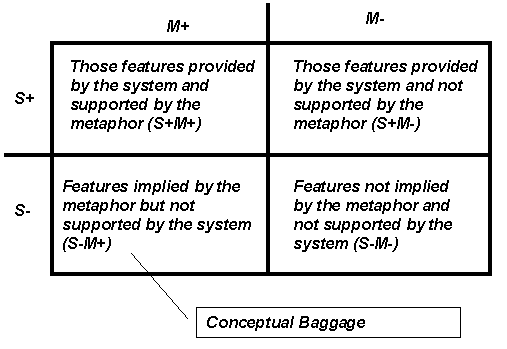
| |
|
|
|
Anderson, B., M. Smyth, R. Knott, J. Bergan, and J. Alty. 1994. Minimising Conceptual Baggage: Making Choices about Metaphor. In Proceedings of HCI'94. Glasgow, UK.
The idea is based on a grid in which functionality of the system and properties of the meatphors are listed in the appropriate boxes.

A good metaphor should have key features in common, so key features of both the metaphor and system should be in the S+M+ box.
If there are many features appearing in the S-M+ box, the metaphor carries conceptual baggage, which means that the metaphor is likely to suggest functionality or facilities which are not present in the system. Metaphors with a large amount of conceptual baggage should be avoided.
Features appearing in the M-S+ box are features which exist in the system, but are not supported by the metaphor. Unless these system features are key features, the metaphor may still work very well. In fact, one of the criticisms of interface metaphors is often that they restrict the functionality of the system. However, this does not have to be the case - to have a system which extends beyond the limits of a metaphor is often desirable.
The following example shows how the recyclebin metaphor relates to the delete functionality of Windows95/98.

The key properties, i.e. being able to throw documents away (and recycle the paper/space), and retrieve these documents before the bin is emptied are common features of the system and the metaphor. There is minimal conceptual baggage, so the metaphor can be considered suitable.